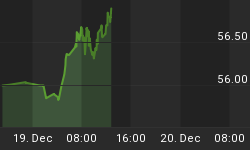In mid 2001, we were at a dinner party catching up with a friend who makes his living as a commodities broker. After the "How are the kids?" and "How is your family?" pleasantries were exchanged, we asked him how business was. His reply was that business was somewhat slow in general and then he added "interest in gold and silver has been dead". Several days later, gold reached its bottom.
Since that fateful day three and a half years ago, gold and silver have both shown healthy appreciation while the stock market has remained in the doldrums. Despite the run-up in bullion prices and precious metal shares, we think that the bull market in gold and silver has just begun. Our thesis is mainly derived from the bullish fundamentals of the yellow and grey metals as well as the bearish fundamentals of the U.S. Dollar. In addition to favorable fundamentals, we think that there are sociological signs that the bull market in gold has just started. We thought it would be helpful to depart from crunching the numbers and discuss what a gold bull market looks like in terms of popular culture.
Phase 1 of the Gold Bull - Planting the Seeds at the Bottom:
Pessimism is at its peak as industry experts (such as our commodities broker friend) declare that the gold market is "dead". Gold, labeled by the social elite as a "barbaric relic", is off everyone's radar screen as an investment. Only the most die-hard gold bugs keep the faith and buy up bullion or precious metals shares. Gold continues to lag in the doldrums.
Phase 2 of the Gold Bull - The Very Smart Money Nibbles:
Wealthy families and sharp hedge funds begin to look at the fundamentals of the precious metals and start to allocate capital to the sector. The price starts to rise, but 99.9% of the public has no idea what a Krugerrand is. The mainstream media (CNBC) cites terrorism fears or oil prices as reasons why gold's price has risen but still mocks those who consider gold as an investment. This is where we are today.
Phase 3 of the Gold Bull - The Upper Class Takes Notice:
The "wall of worry" is being climbed faster and faster as more hedge funds and high net worth families (doctors, lawyers, etc) discover gold as an investment. As official inflation reaches 7-10%, the media realizes that a growing section of the public has an interest in gold and loses its hostility towards precious metals. For the first time in decades, gold and silver bullion coin shop growth is large enough to warrant a multi-page section in the yellow pages.
Phase 4 of the Gold Bull - The Mainstream Gets in on the Action:
Victory! Gold has won its battle after 25 years of futility. Like Internet stocks in the mid 1990s, 5% daily increases in the price of gold are common. Wall Street analysts are seen on television talking about XYZ Mining Co.'s new Peruvian mines instead of Cisco's book-to-bill statistics. Mainstream mutual funds are now allocating a minimum of 5% to gold shares, just like in the early 1980s. We have no idea when this will occur, but this would be an appropriate time to start taking some profits.
Phase 5 of the Gold Bull - The Bubble:
Suze Orman is on television pitching gold stocks to a room full of empowered female investors. American Ivy League college students covet jobs where they can move to Vancouver and, after a few years of experience, raise enough capital to start their own mining company. Wall Street Week on PBS is replaced by Howe Street Week. Gold & silver newsletters and magazines begin to appear at book stores around the world. Once any of these symptoms appear, then you know it is time to liquidate. It's better to sell a little early than to get too greedy.
The preceding scenarios may sound a little ridiculous, but we think some reasonable variation of this is likely to occur. Bull markets grind their way higher and suffer steep short declines that scare out the weak hands and set the stage for the next rally. This is exactly what gold has been experiencing and we expect good things to come in the future.















